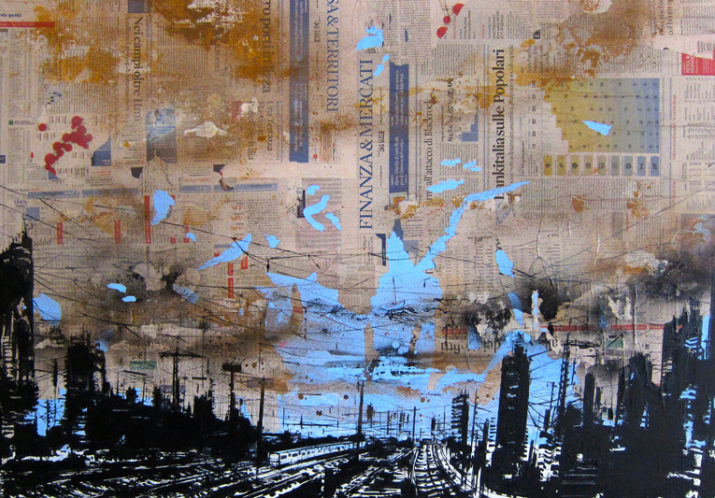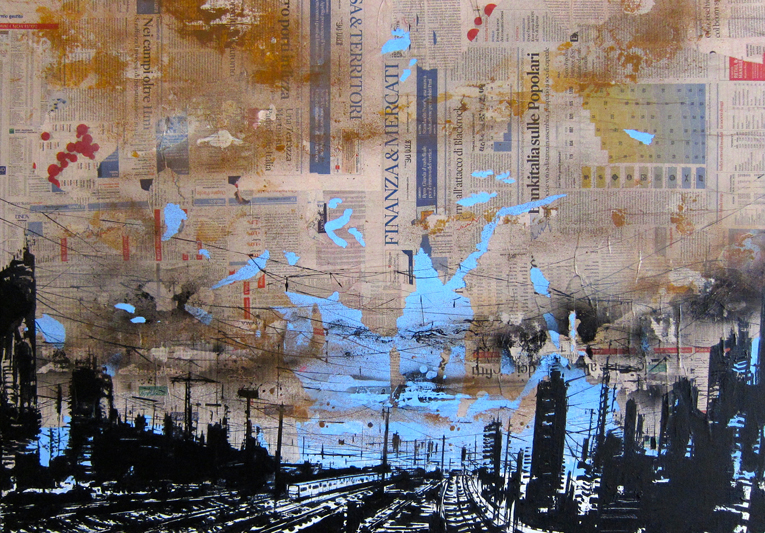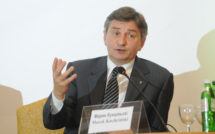

There is nothing more vague and ambiguous than the concept of the suburb; it cannot exist on its own, it can only do so in connection with the center, in a never-ending and repetitive connection of meanings, a spiral of reciprocal definitions that Saint Thomas Aquinas called infinitum ad quem.[1]
There are suburbs that inevitably gravitate towards a single center, while others have more than one. The history of Western civilization, as per intended by the French scholar Fernand Braudel, is about a series of processes of centrage-recentrage, of birth, ascent, and decline of centers that were, at the same time, epicenters of big economic empires and suburbs, both external and internal.[2] A historic sequence of centralities in which the powers, over the centuries, shift and change their location. There were also extreme suburbs, the spaces that the German economic historians called Außen-arena, a sort of external ground where the barbarians (Naturvoelker) lived, opposed to civilized people (Kulturvoelker). Lands populated by inferior creatures on the fringe of the developed worlds, neither interesting nor useful even from an economic point of view.[3] Europe was a cultural and economic machine producing suburbs, creating hierarchies, establishing taxonomies. Generally, speaking, the suburbs for Europeans were always the others.
In European culture we still see a strong tendency towards this kind of binary oversimplification, even though it probably is just a misleading paradigm, an outdated vision of the world, no longer telling us anything.
Times are rapidly changing and it seems like that attempt to “provincialize Europe,”[4] which was the aim of the Postcolonial Studies, is becoming a reality; not only from a cultural perspective, where we undoubtedly see old paradigms shifting, but also from a social and spatial one.
In fact, suburbs grow larger and large in Europe as well, and urban decline intertwines with the birth of neighborhoods of discrimination and relegation. The so-called shrinking cities are growing, like Leipzig or Genoa or Ostrava,[5] but also cities like Milan, once at the top of world rankings, are starting to slip; only the biggest European metropolitan areas such as London, Paris, Frankfurt and Munich seem to be able to withstand competition.
The issue here is not just about becoming less important on the international rankings of the most important cities, but, first and foremost, a matter of “becoming suburb” of big parts of European cities, of developing new kinds of poverty and living conditions rarely experienced before. This process leads, therefore, to the birth of actual shanty-towns, from Cañada Real Galiana in Madrid, where around forty-thousand people, mostly immigrants, live in conditions of abject poverty,[6] to the ones arising in Milan’s hinterland[7] or in Naples’ and Rome’s suburbs, not to mention the Calais “Jungle.”[8]
For these reasons, nowadays, the growth of suburbs in Europe can be seen as a symptom, a signal and, at the same time, as an opportunity.
It is a sign of a new fragmentation, of fast-approaching chaos, but also of a redefinition of the balance of powers. The suburb as it was intended by Fernand Braudel, conceived as a territory where a politically and geographically defined centrality could exert its extreme powers, will soon be a distant memory.
Globalization, which was once hoped to be a vehicle of political integration worldwide, now brings more and more divisions and separations. Some territories win, some lose. Powers grow polycentric: more centers, more suburbs, and the suburbs end up absorbed by the very centers. Maps that were thought to be eternal dissolve. In the atlas of the world, a confused mass of powers is coming back to light, not too different from the medieval Territorium.[9]
What about the European city? What’s left of its heritage and tradition? Some believe that cities in Europe still maintain their peculiarities, which make them different from other urban realities, from an administrative and social perspective as well as a place of ancient emancipation, strongly characterized by their architectural and urban history.[10] However, the threat that cities in Europe are about to face is that of experiencing a phase of transition, where their main historical traits risk to become just a “temporary model,” waiting for the consequences of globalization to transform their social and spatial structures even more radically. European cities seem to be slowly bending to global needs, to lose part of their peculiarities in favor of a sort of capitalism that is taking advantage of them for its own purposes. What will probably remain of European cities is a postcard picture good enough for selling worldwide, while the social dimension and the ability to stimulate integration slowly disappear. We shouldn’t, however, underestimate their strength, which makes us trust in their ability to resist and adapt to such a transformed panorama, as Patrick Le Galès often stated.[11] In the transition from a Ford-keynesian welfare-state to a competitive post-keynesian state, with a process of rescaling and re-allocation of skills in which the privileges once belonging to nation states are now transferred to super-national or sub-national states, powers shift and, contrary to Le Galès’ hypothesis, it will be hard for European historic characteristics to survive. They will be crushed by global and interurban competition. In a similar perspective of “urban locational policy,” new patterns of prosperity and marginalization would tend to appear, gradually replacing the old urban hierarchies and triggering the overpowering decline of welfare systems.[12]
Globalization, although economically productive, proves itself misleading regarding the hope of conditioning important choices starting from the territory, of having the power to influence politics, meant as the ultimate decision-making power.[13] Although urban identities and local histories are now being deeply analyzed, they don’t seem to be very relevant.[14] It is not just a rehash of the old issue of European cities tending towards “Americanization,” of the reception and superimposition of a productive and social model as alien as the American urban model was and still is, characterized by social division and “primitive” social and Darwinian ideologies about development. America is just a pretext, whole parts of it are already suburbs, ghettos, as shown by Loic Waquant;[15] it is not just the American model appearing on the horizon, rather the shadow of global cities reaching Europe that suggests that there is an ongoing irresistible attraction towards a different urban life model, characterized by extreme social polarization.
The hypothesis of Global Cities, put forward in the past decades by Saskia Sassen,[16] becomes a sort of “self- fulfilling prophecy,” as Robert Merton put it,[17] in the present world situation. Decision-making power is concentrated in the places where the most important decisions are taken, where the processes that reproduce the mechanisms of global accumulation are launched. These are centers of power, diverging and becoming more and more star-shaped, punctiform; it’s where all the communication networks giving a meaning to economy are radiating from. They still entertain a dialogue with the nation states, waiting for their definitive obsolescence.[18] Out of the borders drawn by these constellations of power, the suburbs expand, becoming places where there is no development but, instead, stagnation, where even the possibility of depending on the center is remote. This is due to the fact that there is no longer just one center, but, instead, more than one, that can afford to ignore and forget about the suburb; it is also due to the fact that it is possible to privilege relationships with other centers and to communicate with the suburbs in terms of hidden exploitation, of occasional and predatory use. The reality of suburbs today could be even more dramatic than in the past.
How does the European city, with its centuries-old institutions, grown over a long historical period, so deeply marked by a project of emancipation and equality, fit in this new situation? Does it make sense, in Max Weber’s words,[19] to present it as an “ideal type” of city? Is there an alternative to the model offered by the new, violent global powers that have their material headquarters in the Global Cities? Does a reality able to counteract the unchained forces of neoliberal economy and the commercialization of planet Earth exist? Is there a solution other than passive adaption and the new “colonization” suffered by the huge cities of the Third World? Is there any chance of an autonomous and original development before a large part of Europe becomes a suburb? In a process of overall revision and deconstructionist critique of Western “urban reason,” during the last few years many postcolonial advocates insist on the need of revising the selective association applied within city and modernity on the one hand and the criteria for defining the development on the other. These authors declare that it is important to consider other reasons, other ways of thinking, of organizing and managing the city, reasons that are not necessarily Western. These opinions are gradually making their way while a process of worlding is taking place, in which, as Gayatri Spivak explains,[20] the Western model of the city might not necessarily prevail. Therefore, a still uncertain sociological science or theory of the “postcolonial city”’ is taking shape, having the hagiographic literature about the European city as one of its main controversial points of reference.[21]
In the context of this debate, the “borders of globalization” we were discussing with Sandro Mezzadra more than ten years ago seem to have now been temporarily achieved, thanks to the decisive action of the internal crisis factors of this process.[22] What does that entail for the city? Surely an increase of those ‘irregularities’ in the distribution of Global Cities on the planet’s map, which were already condemned by John Beaverstock and the school of Loughborough Universities during the very first studies on the issue.[23] As the balance of power is changing there’s a substantial shift in the “areas of globalization” creating a new context in which Europe risks to have a minor role to play.[24] At the same time, the ongoing processes encourage the fusion of urban models, stoking a process that, as we mentioned before, brings more and more of the South into the North and even more of the North into the South. The framework of the European cities, which was, in many ways, already problematic and in a phase process of reorientation before the crisis, is likely to turn positively dramatic in the grip of devastating factors such as greater job insecurity, mass unemployment, proletarianization of the middle classes and unexpected migration flows.
In the era of the networks overstepping the traditional spatial frontiers, we are witnessing the birth of new power relations, new borders, and barriers. Cities seem to branch into a series of micro-worlds that barely communicate and sometimes fight against each other. Even the metropolis of the South of the world, despite worlding, are partly globalized or, more accurately, subordinately globalized, depending on command centers located elsewhere, and risk being excluded from development.[25] Most of their inhabitants live in harsh conditions and experience new forms of subjugation and exploitation. The increasing threat of the spread of permanent forms of social and spatial segregation is hanging over urban dimensions developed on values and experiences way different from traditionally “colonial” ones as well.[26]
As we tried to show in the previous pages, the theoretical problem of suburb societies and the comprehension of their specific situation seems to be still completely unsolved and on the agenda in international debates. In this context, all that has to do with suburbs becomes a strategic perspective from which to describe the contradictions of the city and urban development; for this reason, we believe that, in the debate between the European urban model and the southern cities’ worlding, Eurocentrism, which spoils interpretations of the issue, should be abandoned. We must widen our gaze towards the urban realities of the poorest areas of the world, to prompt the arising of hybrids and asymmetries that are born in and between cities belonging to distant parts of the world, and that make the relationship between central and marginal elements more and more complex. Every day it becomes more and more evident how the organization of information flows, capitals and goods, which represents the strength of global and globalized cities, is founded on the exploitation of marginalized spaces, which are now under a new kind of domination, which applies to slums of huge cities in the developing countries and the old Fordistic suburbs, marginalized by the productive system’s changes and the crisis of the welfare systems, alike. The new dynamism of the city seems to be hinting about a constantly evolving horizon much more than about fixing new certainties and stabilities.
Somewhere, the resources exist. If the centers of the European cities tend to become the kingdom of transnational élites, associated with extra-urban universes, selfish and cosmopolitan only from in a purely instrumental way, and with major global centers’ network in order to survive, maybe then the best that the European city has produced, namely the values of pride, freedom, awareness and subjectivity, its differentia specifica, tend to be rejected and confined to the suburbs.[27] Here lay possibilities and, in this sense, we must start to think about suburbs in a different way. Maybe the world needs to be re-thought, starting from the edges. The inner potential that is curdled and paralyzed in them has to find its own way to express itself; that cooperation which is the hidden figure, what’s left unsaid of the Global City, can find in the suburbs its unveiling moment as essence and destiny of the metropolis. Therefore, the European suburb is the place from which a wider debate about equality and rights can start. Producing and supporting policies of resistance, even just locally, means trying to reintroduce, in this age of misery, the utopia of global solidarity.
In other words, the threat of either the European cities’ transformation into suburbs or the cities’ evolution in a conflictual sense, and the possibility of becoming a minority (not only as consequence of a “replacement” process of worlding starting from below), doesn’t seem so improbable. The integrational and social aspects of the European city are exactly what can still be considered, in spite of the present situation, as universal values on a global scale. Max Weber suggests to think about politics starting from the city as a place where history is written, to understand that a city is not just a ”State within a State” but an independent associative and relational space where those who don’t have any power can be citizens, self-defining individuals. In this context, the European city has created a theoretical construction and a powerful myth at the same time, which, as Walter Benjamin suggests, are to be used against the modest and sometimes contradictory reality of contemporary European cities.[28] This is the only way in which a renewal of a point of view that would otherwise be obsolete is possible, opening it to necessarily changes. The city was, in Europe, the place of never-ending social transformations and in their ability to change lies their greatest inner strength. This concept of the city can find today its proper value, retrieving some of its peculiar characteristics and, in particular, its past political nature, to be used again in a rapidly-changing world allowing us to gaze into a different future. The city of tomorrow may be able to overtake and forget about the problem of the suburbs only if the urban space present itself as a place of promotion of human rights and if the current trend setting differences as permanent stops.
Agostino Petrillo, PhD Sociology, is Associate Professor of Urban Sociology at the Polytechnic University, Milan.
Published on March 3, 2017
Photo: Francesco Barbieri, Milano big city of dreams (nothing moves but the money), 2014
References:
[1] T. Aquinas, Summa Teologica, Benziger Bros New York 1948
[2] See F. Braudel, La dynamique du capitalisme, Flammarion Paris 1985
[3] See W. Roescher, Geschichte der National-Oekonomik in Deutschland, Schaeffer-Poeschel Verlag 1992 (reprint 1° ed., Muenchen 1874)
[4] D. Chakrabarty, Provincialising Europe: Postcolonial Thought and Historical Difference, Princeton University Press, Princeton NJ 2007
[5] See W. J.V. Neill, H. Schlappa (eds.), Future Directions for the European Shrinking City, Routledge, London 2016
[6] See R. Keller, Cañada Real Galiana, Madrid, the largest slum in Europe, downloable at https://www.ethz.ch/content/dam/ethz/special-interest/conference-websites-dam/no-cost-housingdam/ documents/Keller_final.pdf
[7] See A. Tosi, M. Ambrosini, Favelas di Lombardia, IRRE, Milano 2009
[8] See M. Agier (ed.), Un monde de camps, Paris, La Découverte, 2014
[9] See A. Petrillo, Max Weber e la sociologia della città, Angeli, Milano 2001
[10] See W. Siebel (Hrsg.), Die europäische Stadt, Suhrkamp, Frankfurt am Main, 2004
[11] See N. Brenner, New state spaces. Urban governance and the rescaling of statehood, Oxford University Press, Oxford 2004
[12] See P. Le Galès, Le retour des villes européennes, 2e édition augmentée d’une préface inédite, Presses de Sciences Politiques, Paris 2011
[13] See A. Petrillo, The Forces of Attraction. Cities between Flows and Places, in C. Ranci, R. Cucca (eds.), Unequal Cities. The challenge of post-industrial transition in times of austerity, Routledge, London and New York, pp.45-68
[14] See M. Loew, Die Eigenlogik der Staedten, Suhrkamp, Frankfurt 2012
[15] See L. Wacquant, Urban Outcasts, Polity Press, London 2008
[16] See S. Sassen, The Global City. New York, London, Tokyo, 2nd rev. ed., Princeton University Press, Princeton NJ 2001
[17] R. K. Merton, The Self-Fulfilling Prophecy, in The Antioch Review Vol. 8, No. 2 (Summer, 1948), pp. 193-210
[18] See G. Arrighi, B. Silver, Chaos and Governance in the Modern World System, University of Minnesota Press, Minneapolis 1998
[19]M. Weber, The City, translated by D. Martindale and G. Neuwirth, New York 1958
[20] See G. C. Spivak, In Other Worlds. Essays in Cultural Politics, Routledge, New York and London 1987
[21] See. A. Roy, Worlding the South. Toward a post-colonial urban theory in S. Parnell, S. Oldfield (eds.), The Routledge Handbook on Cities of the Global South, Routledge, New York and London 2014, pp. 9-20
[22] See S. Mezzadra, A. Petrillo, Introduzione, in Id. I confini della globalizzazione. Lavoro, Culture, Cittadinanza, Manifestolibri, Roma 2000, pp.7-38
[23] See J.V.Beaverstock, R.G.Smith, P.J.Taylor, A Roster of World Cities, GAwC Bulletin n.5, Loughborough University 1999; also see Taylor P.J., World City Network. A Global Urban Analysis, Routledge, London 2004
[24] P. Dicken, Global Shift. Mapping the Changing Contours of the World Economy, Sage Publications, London 2007.
[25] See S. Chakravorty, Urban development in the global periphery: The consequences of economic and ideological Globalization, in Annals of Regional Science n.37, 2003, pp.357-367
[26] See L. Wacquant, Urban Outcasts, Polity Press, London 2008
[27] See A. Petrillo, Peripherein. Pensare diversamente la periferia, Angeli, Milano 2013 e 2016
[28] See W. Benjamin, Das Passagenwerk, in Gesammelte Schriften, vol. V, Suhrkamp, Frankfurt 1991




